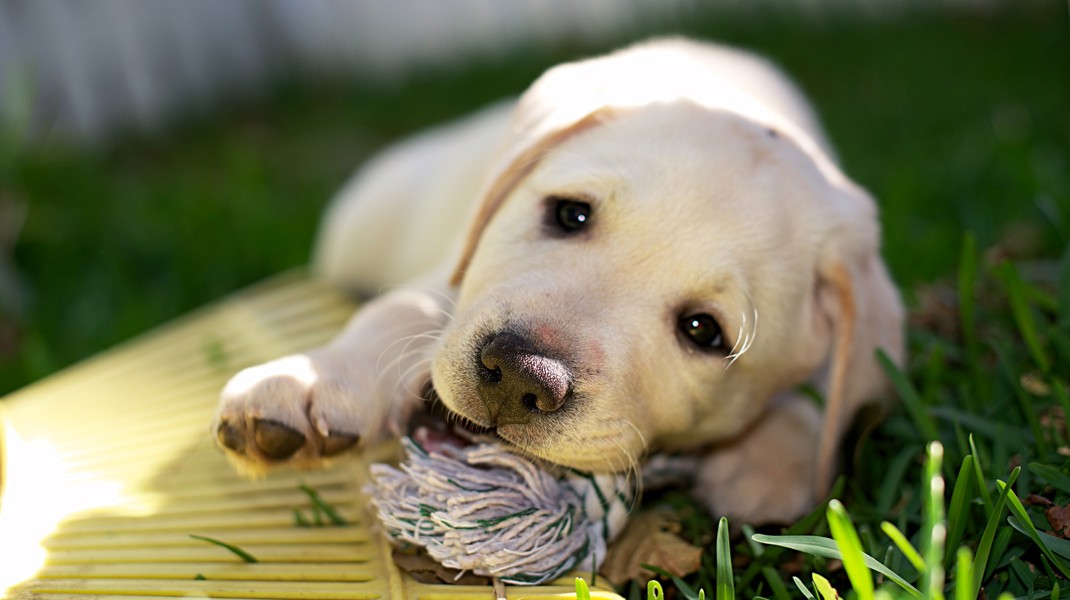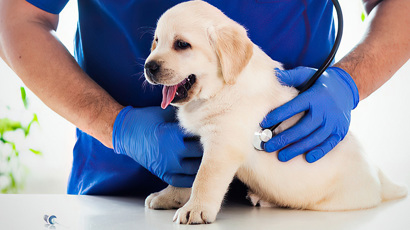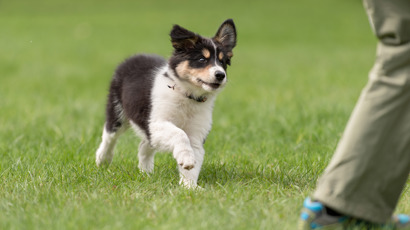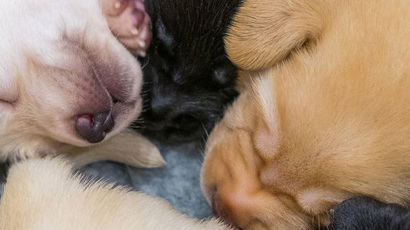Welcoming a new puppy into the house

In the excitement of getting a puppy, it can be hard to keep track of everything you’re supposed to be doing – keeping the new arrival safe, encouraging good habits, and ensuring it grows up to be healthy and strong. For tips on everything from puppy-proofing, toys and training to how to give your puppy the best start to life, we talk to veterinary behaviourist Dr Jess Beer.
When it comes to cute, it’s hard to top a puppy. These little animals are curious, fun-loving, snuggly and, what’s more, they become loyal companions.
But the benefits of welcoming a puppy into your home go far beyond the cute factor – companion dogs are proven to boost health, reduce stress and increase overall fitness (thanks to those daily dog walks).
Dr Jess Beer is well qualified to appreciate the puppyhood journey, having seen hundreds of dogs and their owners through her Auckland business, Kiwi Vet Behaviour.
Puppy Checklist - Essential Supplies
- Puppy food and bowl, plus a water bowl
- Collar (replace or adjust as the puppy grows) and lead
- Toys
- Crate
- Grooming supplies
- Flea and worm treatments
- Toilet training pee pads
- Bedding (use old blankets until the pup is toilet trained)
Setting Up
It’s good practice for all prospective puppy owners to puppy-proof their homes before bringing home the new arrival. Look out for hazards within puppy range, including electrical wiring, poisons, small objects that may cause choking, and anything delicate that’s likely to be toppled over, collided with or chewed on.
It may be easiest to restrict access to certain parts of the house until the pup is properly settled, using baby gates, or simply by keeping doors closed.
Other members of the household, especially children, should be briefed prior to the puppy’s arrival. Teach children to handle the pup gently and discourage behaviours that could be seen as threatening or challenging, such as fast movements or sustained eye contact.
First Days
It’s a big, unfamiliar world out there for a new puppy, so try to dedicate at least the first day home to helping it transition to its new life. Scent or familiar objects from where it was raised can help, according to Jess.
“Bring an object from the environment it was in – it can be quite scary for a little puppy so you want to familiarise them with something that they already recognise. A piece of bedding, the same toy; it all helps.”
You could use something like the Yours Droolly Fill Me Droolly Dog, a comforter toy that can be stuffed with cloth.
At the beginning, keep the puppy in one room until it feels comfortable in the new space. Set up an accessible, quiet area with blankets so it can slip away if it’s tired or overwhelmed. Dogs are den animals, and generally prefer sheltered spots like covered crates (if you have a wire crate, try throwing a blanket over it). Yours Droolly have a variety of quality pens and crates in different sizes.
Once your pup is feeling more confident, the rest of the house can be explored in stages. If the puppy is skittish, it might help to use a lead when getting acquainted with new areas – particularly outdoor spaces.
The settling-in period varies between puppies; some need almost no time at all, while others may be nervous or sleep most of the day. Be patient and pull back on the new experiences when you notice the puppy is looking overwhelmed. For particularly nervous puppies, products like Adaptil, which mimic the pheromones their mothers produce, can help them cope with the transition.
Feeding
Puppies need specialised, high-energy diets to support their rapid growth and immune systems. The best way to achieve this is by feeding a high-quality, formulated puppy food – this takes all of the guesswork out, setting your pooch up for many years of good health.
Puppies need to be fed more frequently than their adult counterparts – generally three times a day until six months of age, then twice daily until a year old. Thereafter, feed once or twice a day. How much to feed will depends on the dog’s breed and size – check with your vet or the packet instructions.
How long to feed a puppy diet also varies between breeds. Generally, smaller breeds switch to adult food earlier (at around 12 months), as they have a shorter growth period. In large breeds, it’’s usually recommended to continue with puppy food until they’re between 18-24 months of age. When making the transition to adult food, introduce the new food slowly over a few weeks. Start by mixing a little new food with the puppy food and gradually increase the ratio. Watch our transition video here.
Dogs should always have access to fresh, clean water.
Family Introductions
It’s less stressful for the puppy to meet the family one by one. Keep introductions calm and quiet, and take care not to crowd the dog – let it come and get acquainted when it’s ready.
“The goal is that the puppy has positive experiences with humans. When they meet a new human, throw a treat down, and reward for confidence. It helps to toss the treat down so they move away from jumping up.”
A similar approach applies to non-human members of the family. Introduce them one at a time, and watch out for signs of aggression. It’s important that they all feel comfortable, so let the pets approach each other in their own time.
Cats can be the most difficult to introduce to a new puppy. Jess offers a simple strategy: “The key is to have a safe place for cats to get away to, and ensure the puppy never chases the cat. The dog should be on a leash or in a crate, so that the cat can build up confidence and start learning that the presence of the dog is a good thing – it gets treats and knows it can get away if it wants to, but doesn’t feel threatened by the puppy.”
Mixing their scents can also be useful.
“Allow the animals to get used to each other without direct contact – bring through the cat’s bed so the dog can smell it and recognise the presence of another animal in the house without wanting to act on chasing it.”
Play Time
Puppies love to play, and it’s a great way to build a bond between dog and owner. However, keep in mind that most puppies (and many adult dogs!) don’t know when to stop, so it’s up to you to make sure they’re not getting exhausted. Puppies need nap time as much as they need play time.
When it comes to toys, there’s a huge range of options. Jess recommends two types in particular: “The first is some kind of squeaker toy – they tend not to last long but are a really good way of getting their attention, which is great when you’re trying to distract them away from something you don’t want them to chew on, like your shoes.
“The other type that is essential, especially for teaching puppies to be quiet or have alone time, is a food-dispensing toy that you can stuff with food or peanut butter, and the puppy can just chew and be content over a longer period of time.”
Use a toy, rather than hands or household items when playing with your pup, to encourage good habits.
“Puppies like to mouth everything, but we don’t want them to mouth human flesh. It might not hurt now, but it will when the pup gets a bit aroused,” says Jess. “That’s when we do a swap-out game. If they’re launching at you or tugging at your clothes, you squeak the squeaker, grab their attention and give them a more appropriate item to chew on.”
Toy and play preferences vary between individual dogs, and are often breed related. Retrievers, for example, love playing fetch, while terriers are keen tuggers. Scent hounds often enjoy a game of kibble hide and seek, which allows them to use their clever minds and acute sense of smell. Plush toys are a great comfort and adored by some puppies, but are doomed to swift destruction in the company of others. Finding the right toy is often by trial and error.
Teething toys can be a property saver when your pup’s permanent teeth start to come through, at around four to five months of age. Teething puppies, like babies, feel discomfort and may chew on whatever they can find. Teething toys offer an appealing, safe alternative to your belongings. Jess recommends rotating toys daily, particularly during teething, to keep them interested.
When shopping for toys, look out for products that have been tested and are safe for puppy use.
Make sure to buy products appropriate for the size of your puppy, and remove them when the pup has outgrown them, as smaller or less hardy toys suitable for puppies can be choking hazards for larger dogs.
Toys should always be used under supervision, as even certified-safe toys may break and become a hazard – for example, a squeaker may come out of a soft toy and cause choking.
But you don’t have to spend a lot of money.
“You can give them something as simple as a sock wrapped around a water bottle – you just need something they can’t destroy or swallow".
Grooming and Dental
Grooming needs differ vastly between breeds, and should be a consideration when choosing a puppy. But, whatever the breed, there will always be some element of grooming involved, and this should start right from puppyhood.
Most dogs need to be eased into handling of their sensitive areas like ears, eyes, mouth and paws. Get them comfortable with regular, gentle manoeuvring of these parts before implementing more intrusive routines. Try to make the experience rewarding, with lots of praise or rewards immediately after.
Regular tooth brushing is recommended, but can be difficult. Work up to brushing in stages – start by moving the lips aside and running your finger over the gums before trying to gently open the mouth. Once the puppy is used to the handling, get them used to licking dog-safe toothpaste (do not use human toothpaste) off the toothbrush. From there you can try for a bit of brushing, starting with a couple of the back teeth (front teeth are more sensitive).
Wait until all of their adult teeth are in before attempting a full clean – brushing wobbly baby teeth can be painful and might cause your dog to develop an aversion to having its teeth brushed. Human toothpastes should never be used when brushing your dog's teeth, as some may contain ingredients which are toxic to dogs. Canine toothpastes are safe and available in appealing flavours like chicken, which will make the process much more enjoyable for your pooch.
Grooming is also useful for keeping tabs on your pet’s health. One thing to look out for in puppies, aside from unusual growths or injuries, is their dental development. Puppies should have a full set of baby teeth by 12 weeks of age, and all of the adult teeth should have come through by the sixth month. If the teeth don’t erupt, or if any of the baby teeth fail to fall out, they will need veterinary help.
Grooming should always be carried out with canine-specific products. Yours Droolly have a great range of grooming products for different breeds, as well as for puppies.
Vaccinations
Puppies should have their first core vaccination at six to eight weeks, with boosters every three to four weeks until 16 weeks of age. Diseases that core vaccinations build immunity against include distemper, hepatitis and parvovirus, and often breeders give puppies the first round before adopting out. Leptospirosis vaccines are recommended, particularly for dogs that may come into contact with rats, as well as the Bordetella (kennel cough) vaccination. After the final puppy vaccination, a yearly booster shot maintains immunity.
Jess offers some advice for those trying to balance keeping their pups safe during vaccination and getting them adequately socialised.
“Speak to your vet or puppy trainer about safe, local places to expose your puppy to, waiting until at least one week after the first or second vaccination (depending on your risk of parvo in your area). Friends with dogs are ideal for playdates. You could carry your puppy in public to prevent contact with the ground, allowing them to see and smell the world. Also, the beach at low tide is often a good setting as the twice-daily tides help to keep it clean.”
Training
As is often said, consistency is key to training, and this needs to start immediately.
From when to sleep to where to toilet, a pre-established routine will help puppies settle in – the more they know about what’s happening each day, the more confident they’ll feel.
Because of this, training really needs to start before your puppy comes home – guidelines need to be set and agreed on by everyone in the household.
“Having a training philosophy as to how the dog is going to be raised, and keeping everyone on the same page, is essential. You’ll run into trouble if half of the family is doing one thing, and the other half is doing another. Puppies often develop bad habits because of confusion or mixed messages from members of the household,” says Jess, who is a strong advocate for reward-based learning.
Dogs need to be rewarded for doing the right thing; that’s how they learn, that’s what the science is telling us. Some people say they don’t want to bribe their dog, but if it’s not enjoyable for the dog, then why would they do it?
No one should be afraid of using treats to train a dog, it’s a very simple way to let the dog know that you’re pleased with what they’ve done. It’s so fast and so easy for the dog to go ‘yes I love you, I’m going to do that again'.
If you’re worried about your dog’s weight, however, you could use toys or other rewarding experiences, or kibble from their daily food allowance.
Once a behaviour is ingrained, you won’t need to reward every time, but this takes time. If you’ve stopped rewarding and find the dog becoming a little slack, start again.
Verbal Cues
The two most basic words, ‘no’ (or ‘stop’) and ‘good’, usually don’t need to be formally taught – as long as you use them consistently with the same tone of voice and body language, your pup will glean the meanings soon enough. They are essential for encouraging or discouraging certain behaviours, and teaching other commands. However, Jess notes that “when using words like ‘no’ or ‘stop’, follow up with guidance on how to replace the behaviour, as simply stopping it can be frustrating when they don’t have an alternative ‘good’ behaviour to offer you.”
Useful cues include ‘sit’, which puts them in a position where they can’t easily leap up or rush off; ‘stay’, which ensures a well-behaved dog that doesn’t go venturing when you don’t want it to; and ‘come’, when the dog drops whatever it’s doing and comes back to you. ‘Down’ is another good one, especially for social settings like cafés, “once they settle into that ‘down’ they should start to relax, and hopefully roll over and go to sleep,” says Jess.
Jess has one more that she likes to teach in her puppy classes: ‘touch’. “It’s when you put your hand out flat and they stick their nose on it. It’s a really good focus game to get them to look at your hand rather than something else they’re worried about or that they want to chase. It becomes useful later on, for things like vet checks, to get them to focus on you and pay less attention to what the vet’s doing.”
The trick to teaching cues is consistency and pairing the cue as close as possible to the moment they are in the desired position – then rewarding immediately.
“A lot of people go ‘sit, sit, sit’, and the dog eventually puts its bum down, is praised, then stands up and gets a treat. So it’s learning that standing up gets the treat.
“When I first start teaching puppies I lure them into receiving the treat – as soon as they get into position, I give them the verbal cue and give them the treat,” says Jess.
Other essentials to think about are microchipping, registering and desexing. You should also check your local council’s website for restrictions on dogs in your area.
Toilet Training
According to Jess, anticipation is imperative to toilet training success.
“The key is having them outside before they need to go. Every couple of hours, pretty much, they’re going to need the opportunity to be in the right place to go to the toilet. If they’re doing it outside, they start associating that place with where they feel that relief, and they’ll learn.”
The odours left behind will also prompt pup to toilet in the same place the next time.
By adoption age, most puppies will have picked up some degree of toilet training. However, they have small bladders and poor control, so accidents are likely. Watch out for signs that your pup is ready to go – sniffing around, circling, pawing at the door – and take it outside immediately. When your pup is not under anyone’s watchful eye, try using puppy pads – Yours Droolly Training Pads are leak-proof, super-absorbent, antibacterial and specially designed to neutralise odours.
Crates are also a useful tool in toilet training. Most dogs don’t like to toilet where they sleep, so crate time can help teach them to hold on – but make sure you take the pup outside immediately before and after closing it in, and don’t leave it in for more than 2-4 hours at a time (unless it’s sleeping overnight). The crate should not be so big that there’s room for toileting away from the sleeping area.
If your puppy does have an accident, be sure not to punish. This can build fear or anxiety, leading to more accidents, or if you’re not chastising immediately after the act, the puppy won’t understand why you’re angry. Clean up the mess using an odour-killing product so that it won’t be impelled to go again in the same spot.
Small breeds like Chihuahuas can be very difficult to toilet train because of their small bladders – if this is the case, using a litter tray may be the easier route.
Puppy School and Socialisation
Jess strongly advises that every dog goes to puppy school, as this is a great way to make sure that your pup’s manners and social development are on the right track. Look for a teacher whose style and personality work for you and your new pup, and who has some kind of related qualification. The dog training industry is not regulated, so it’s up to you to make sure you get a good instructor.
Socialisation is an essential part of puppy school, and something that needs to be locked down in the dog’s formative months.
“Dogs need to be socialised and exposed to everything they’ll be exposed to in their entire lives, so if it doesn’t happen before the four-month mark they’ll be fearful of it".
Because of the wide range of situations and characters to be introduced, socialisation efforts need to go further than puppy classes alone.
“Take them out at other times – they need to see kids, trucks, wheelchairs, people in hi-vis jackets,” says Jess, “but we don’t want them to be overwhelmed. Sit in a park and reward them when they’re happy, sitting calmly and looking at all the strange people.”


